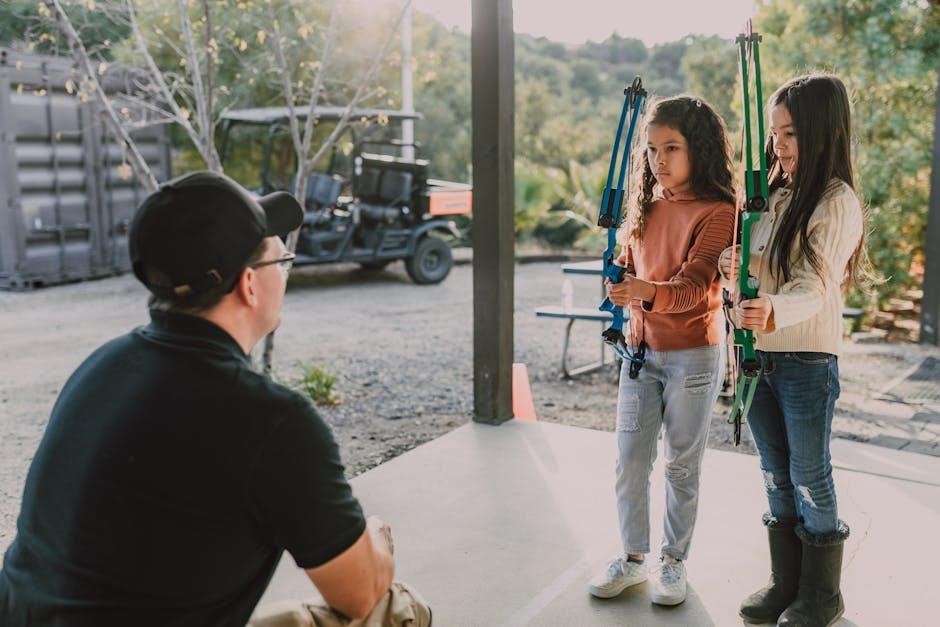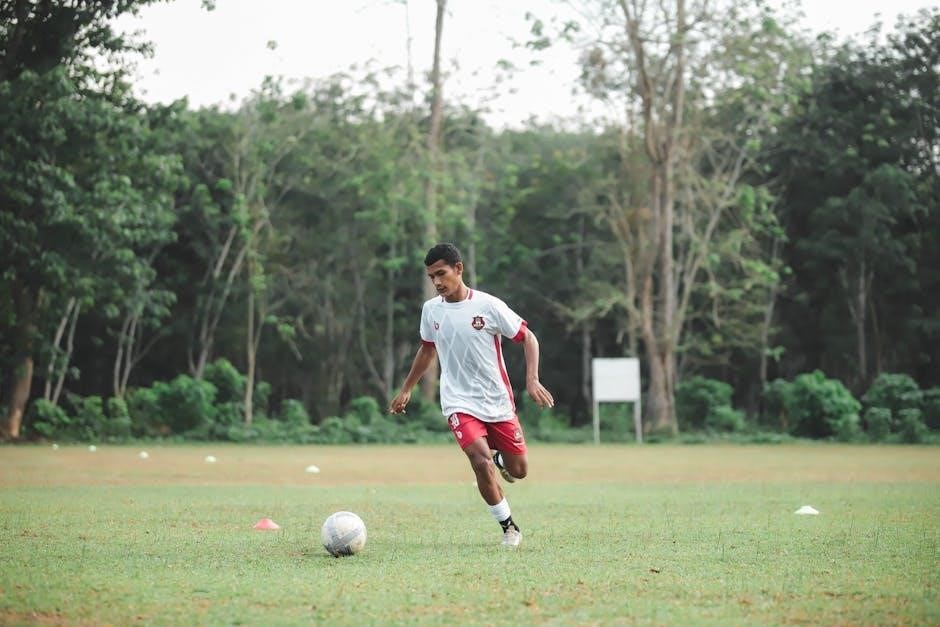
Overview of Guided Practice Activities 5B-2
Guided Practice Activities 5B-2 are integral to the Realidades 1 curriculum. They reinforce grammatical and vocabulary concepts from Lesson 5B-2. These activities provide a comprehensive approach to mastering Spanish, catering to diverse learning styles.

Realidades 1 Curriculum Integration
Guided Practice Activities 5B-2 are seamlessly integrated into the Realidades 1 curriculum, serving as a vital component for reinforcing and expanding upon the language skills acquired in Lesson 5B-2. These activities are specifically designed to complement the textbook material and provide students with ample opportunities to practice and apply their knowledge of grammar, vocabulary, and cultural concepts.
By engaging in these activities, students can solidify their understanding of the material presented in the textbook and develop greater fluency and accuracy in their Spanish language skills. The activities also offer a variety of interactive and engaging exercises that cater to different learning styles and preferences, promoting a more effective and enjoyable learning experience.
Focus on Irregular Preterites
Guided Practice Activities 5B-2 heavily emphasize irregular preterite verbs. Specifically, the activities concentrate on mastering the preterite conjugations of verbs like venir, poner, decir, and traer through targeted exercises.
Verbs Venir, Poner, Decir, and Traer
Guided Practice Activities 5B-2 dedicate significant attention to the verbs venir (to come), poner (to put), decir (to say), and traer (to bring) in the preterite tense. These verbs are crucial due to their irregular conjugations, which deviate from the standard preterite patterns. Mastering these verbs is essential for constructing grammatically correct sentences in the past tense. Activities include fill-in-the-blank exercises, sentence completion tasks, and short answer prompts designed to reinforce the correct usage of each verb’s preterite forms. Students practice conjugating these verbs in various contexts, enabling them to confidently express past actions involving coming, putting, saying, and bringing. These targeted exercises strengthen students’ understanding and application of irregular preterites.

Grammar Reinforcement
Guided Practice Activities 5B-2 place a strong emphasis on solidifying grammatical concepts introduced in the Realidades 1 curriculum. The activities offer targeted exercises to reinforce understanding and application of key grammar points. These exercises include fill-in-the-blank, sentence construction, and verb conjugation drills. Emphasis is placed on mastering the irregular preterite forms of common verbs like venir, poner, decir, and traer. Furthermore, activities provide opportunities to practice using these verbs in context, ensuring students can accurately express past actions. These exercises are designed to solidify understanding, improve accuracy, and boost confidence in grammatical skills, essential for effective communication in Spanish. The activities promote practical application and retention of key grammar concepts.
Skills Covered
Guided Practice Activities 5B-2 cover a range of essential skills. These include grammar, vocabulary, reading comprehension, and writing. These are designed to offer a comprehensive approach to mastering the intricacies of the Spanish language.
Grammar
Guided Practice Activities 5B-2 place a strong emphasis on grammar reinforcement, particularly focusing on the irregular preterites of key verbs like venir, poner, decir, and traer. These activities provide targeted exercises that allow learners to practice conjugating these verbs in past tense contexts. Students fill in missing verb stems, complete sentences, and manipulate verb forms. They are also encouraged to solidify their understanding of verb usage in various scenarios. These grammar-focused exercises aim to strengthen students’ command of Spanish verb conjugation and usage. This will improve overall language proficiency and confidence in constructing grammatically correct sentences.
Vocabulary
Guided Practice Activities 5B-2 actively engage students in expanding their Spanish vocabulary. The activities include exercises designed to reinforce vocabulary introduced in Realidades 1, Lesson 5B-2. Students are challenged to use new words in context. This involves tasks such as completing sentences, matching definitions, and creating original sentences using target vocabulary. The focus is on building a practical vocabulary base that students can apply to real-world communication. These activities encourage vocabulary retention and foster the ability to express themselves effectively. They also promote a deeper understanding of the nuances of Spanish language through active engagement with new words.
Reading Comprehension
Guided Practice Activities 5B-2 incorporate exercises aimed at improving reading comprehension skills. The activities feature passages related to themes explored in Realidades 1, Lesson 5B-2. Students read the passages and answer questions to check their understanding of the text. These questions require them to identify main ideas, infer meanings, and analyze details. The activities also include exercises that focus on vocabulary in context. This helps students develop skills to decode unfamiliar words while reading. By engaging with a variety of texts and question types, students enhance their ability to comprehend written Spanish and improve their overall language proficiency.
Writing
Guided Practice Activities 5B-2 include a variety of writing exercises designed to improve students’ ability to express themselves in Spanish. These activities often require students to write sentences, paragraphs, or short essays based on prompts related to the lesson’s themes and vocabulary. The exercises might ask students to describe people, places, or events, or to express their opinions or preferences. Students are encouraged to use the grammatical structures and vocabulary they have learned in the lesson. Feedback is provided to help students improve their grammar, vocabulary, and overall writing skills. Through these activities, students gain confidence in their ability to communicate effectively in written Spanish.

Examples of Activities
Guided Practice Activities 5B-2 offer diverse exercises. This includes solving linear equations, graphing linear equations, and finding slope and y-intercept. These activities reinforce mathematical concepts and problem-solving skills in students.
Solving Linear Equations
Solving linear equations is a fundamental skill reinforced by Guided Practice Activities 5B-2. Activities often involve manipulating equations to isolate variables. For example, students may solve equations like 2x + 5 = 11, 3y ౼ 7 = 10, or 4z + 2 = 18. These exercises strengthen algebraic manipulation skills. They also help to reinforce a student’s understanding of inverse operations. By working through varied problems, students gain confidence. This also includes achieving proficiency in solving linear equations. Such practice builds a solid foundation for more advanced mathematical concepts. Activities may also include word problems requiring translation into linear equations. This adds a layer of complexity and real-world application.
Graphing Linear Equations
Graphing linear equations is visually reinforced through Guided Practice Activities 5B-2, enhancing understanding of linear relationships. Students graph equations like y = 2x + 1, y = -3x + 5, and y = 1/2x ౼ 2, solidifying their grasp of slope-intercept form. Graphing activities deepen the understanding of how changes in the equation affect the line’s position on the coordinate plane. These exercises also improve the ability to interpret visual representations of mathematical relationships. Further skill development also includes plotting points, drawing lines, and recognizing the correlation between the equation and its graphical representation. Ultimately, this strengthens students’ understanding of linear functions and their applications in various fields.
Finding Slope and Y-Intercept
Guided Practice Activities 5B-2 include exercises focused on determining the slope and y-intercept of linear equations. These activities reinforce understanding of the slope-intercept form (y = mx + b), where ‘m’ represents the slope and ‘b’ represents the y-intercept. Students practice identifying these key components from equations, which strengthens their analytical skills. Understanding slope and y-intercept is crucial for graphing and interpreting linear relationships. Students also learn how to convert equations into slope-intercept form, allowing them to easily identify these values. These exercises enhance problem-solving abilities and build a solid foundation for further study in algebra and calculus. Furthermore, these activities reinforce the connection between algebraic representation and graphical interpretation.
Strategies for Approaching Activities
A consistent approach is crucial for success with Guided Practice Activities 5B-2. Begin by carefully reading the instructions for each activity. Identify the specific skill or concept being reinforced. Review relevant vocabulary or grammar rules before starting. Work through examples provided as models. Break down complex problems into smaller, manageable steps. Use available resources such as textbooks, notes, and online materials for support. Collaborate with classmates or seek help from the teacher when needed. Check your answers and correct any errors. Reflect on the process and identify areas for improvement. Practice consistently to build confidence and mastery. Remember, a methodical and persistent approach will maximize learning outcomes and enhance your understanding.
Answer Keys and Resources
Answer keys are crucial for checking understanding and identifying areas needing improvement in Guided Practice Activities 5B-2. These keys provide correct answers to exercises, aiding self-assessment and progress tracking. Textbooks, study guides, and online platforms often include answer keys. Teachers may provide additional resources like worksheets, practice quizzes, and interactive activities. Online forums and educational websites offer supplementary materials and explanations. Collaborate with classmates to compare answers and discuss solutions. Utilize tutoring services or seek help from the teacher for personalized support; Remember to use answer keys as a tool for learning, not just for finding the correct answers. Focus on understanding the concepts and processes involved. Effective use of these resources will enhance your learning experience and improve your performance.
Benefits of Guided Practice
Guided practice offers numerous benefits, enhancing learning and skill development. It provides structured support, allowing students to rehearse, process, and recall new material effectively. This approach facilitates internalization and storage in long-term memory. Guided practice bridges the gap between instruction and independent application, fostering confidence. It allows for immediate feedback, addressing misconceptions promptly. Students actively engage, promoting deeper understanding and retention. The collaborative environment encourages peer learning and support. Guided practice promotes critical thinking, problem-solving, and analytical skills; Consistent application leads to improved performance and mastery. It builds a strong foundation for future learning, fostering independent learning skills. By offering a structured and supportive learning environment, guided practice maximizes learning outcomes and enhances overall academic success. It slowly releases control, leading to independent work.
Scaffolding Learning
Scaffolding learning involves providing temporary support to students, enabling them to accomplish tasks they couldn’t do independently. This support is gradually removed as competence increases. Guided practice serves as a crucial scaffolding technique, breaking down complex tasks into manageable steps. Teachers provide clear instructions, modeling, and prompts. Students receive targeted assistance, addressing specific learning gaps. Collaborative activities, like think-pair-share, offer peer support. Visual aids, graphic organizers, and manipulatives enhance comprehension. Effective scaffolding adapts to individual needs, promoting inclusivity. It fosters a growth mindset, encouraging students to embrace challenges. Regular feedback guides improvement and builds confidence. Scaffolding cultivates self-regulation skills, empowering students to take ownership of their learning. The gradual release of responsibility promotes independence and mastery. This approach ensures all students can access and succeed in challenging content, maximizing their learning potential. It involves “I do, We do, You do” steps.

Error Correction and Feedback
Error correction and feedback are vital components of guided practice. Effective feedback should be timely, specific, and constructive. Teachers should identify patterns of errors, addressing underlying misconceptions. Focus on a few key areas for improvement, avoiding overwhelming students. Use a variety of feedback methods, including written comments, verbal explanations, and peer review. Encourage self-reflection, prompting students to identify their own errors and strategies for correction. Provide opportunities for revision and practice, allowing students to apply feedback. Frame errors as learning opportunities, emphasizing growth and effort. Create a supportive classroom environment where students feel comfortable taking risks and making mistakes. Offer positive reinforcement for effort and progress, building confidence. Align feedback with learning objectives, ensuring it is relevant and meaningful. Use feedback to differentiate instruction, providing targeted support to individual students. Error correction and feedback promotes deeper understanding and lasting learning.
